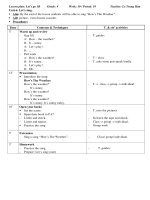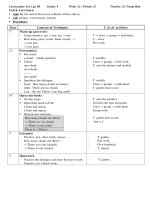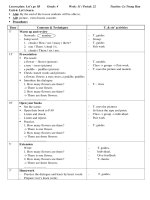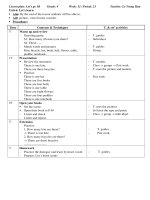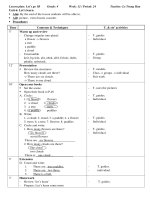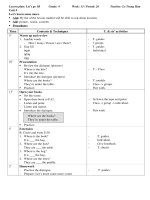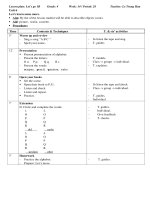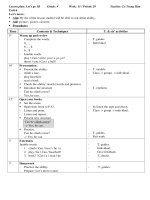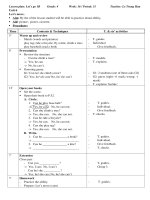Chapter 6: Maxwell’s Equations for Time-Varying Fields
Bạn đang xem bản rút gọn của tài liệu. Xem và tải ngay bản đầy đủ của tài liệu tại đây (2.31 MB, 26 trang )
<span class='text_page_counter'>(1)</span><div class='page_container' data-page=1>
<b>Bài giảng:</b>
<b>TRƯỜNG ĐIỆN TỪ (CT361)</b>
<b> (ELECTROMAGNETICS)</b>
<b>Chapter 6: </b>
<b>Maxwell’s Equations for Time-Varying Fields</b>
<b>Giảng viên: GVC.TS. Lương Vinh Quốc Danh</b>
</div>
<span class='text_page_counter'>(2)</span><div class='page_container' data-page=2>
•
Dynamic Fields
•
Faraday’s Law
•
Stationary Loop in a Time-Varying Magnetic Field
•
The Ideal Transformer
•
Moving Conductor in a Static Magnetic Field
•
Moving Conductor in a Time-Varying Magnetic Field
•
Displacement Current
•
Boundary Conditions for Electromagnetics
<b>Content</b>
2
</div>
<span class='text_page_counter'>(3)</span><div class='page_container' data-page=3>
<b>Maxwell’s Equations </b>
</div>
<span class='text_page_counter'>(4)</span><div class='page_container' data-page=4>
4
<i>Luong Vinh Quoc Danh</i>
<b>Faraday’s Law</b>
Electromotive force (voltage) induced
by time-varying magnetic flux:
- Michael Faraday conducted the
experiments in his Lab in London.
- Joseph Henry discovered the
</div>
<span class='text_page_counter'>(5)</span><div class='page_container' data-page=5></div>
<span class='text_page_counter'>(6)</span><div class='page_container' data-page=6>
6
<i>Luong Vinh Quoc Danh</i>
<b>Stationary Loop in Time-Varying B Field</b>
</div>
<span class='text_page_counter'>(7)</span><div class='page_container' data-page=7></div>
<span class='text_page_counter'>(8)</span><div class='page_container' data-page=8>
8
<i>Luong Vinh Quoc Danh</i>
</div>
<span class='text_page_counter'>(9)</span><div class='page_container' data-page=9></div>
<span class='text_page_counter'>(10)</span><div class='page_container' data-page=10></div>
<span class='text_page_counter'>(11)</span><div class='page_container' data-page=11>
<b>Moving Conductor in a Static B Field</b>
<i><b>Magnetic force on charge q moving </b></i>
<b>with velocity u in a magnetic field </b>
<b>B:</b>
This magnetic force is equivalent to the
electrical force that would be exerted on
<b>the particle by the electric field E<sub>m</sub></b> given
by
This, in turn, induces a voltage
difference between ends 1 and 2,
with end 2 being at the higher
potential. The induced voltage is
<i><b>called a motional emf </b></i>
(6.22)
</div>
<span class='text_page_counter'>(12)</span><div class='page_container' data-page=12>
<i>Luong Vinh Quoc Danh</i> 12
<b>Moving Conductor in a Static B Field (cont.)</b>
</div>
<span class='text_page_counter'>(13)</span><div class='page_container' data-page=13>
<b>Example 6-3: Sliding Bar</b>
The length of the loop is related
<i><b>to u by x</b><b><sub>0</sub></b><b> = ut. Hence</b></i>
<i><b>Note that B = zB</b></i>
<i><sub>0 </sub></i><i><b>x, B increases </b></i>
</div>
<span class='text_page_counter'>(14)</span><div class='page_container' data-page=14>
14
<i>Luong Vinh Quoc Danh</i>
<b>EMF in an Airliner</b>
<b>These questions are about the potential difference induced across the wings of </b>
an aeroplane flying through the Earth’s magnetic field. An airliner is flying due
East from North America to Europe. The Earth’s magnetic field acts at 70° to the
<i>horizontal, and has a strength of 1.7 x 10</i>–4 <sub>(T).</sub>
<i>The charge on an electron = – 1.6 x 10</i>–19<sub> C. The aircraft’s speed is 270 m/s. The </sub>
wing span of the aircraft is 60 m.
70°
North
Earth’s
<i>B-field</i>
</div>
<span class='text_page_counter'>(15)</span><div class='page_container' data-page=15>
<b>EMF in an Airliner (cont.)</b>
The wings cut the flux lines of the Earth’s magnetic field, inducing an emf
between the wing tips. As the aircraft flies through the field, the
north-pointing tip of the wing becomes positively charged and the south-north-pointing
tip becomes negatively charged.
<i><b>Vertical component of B field = (1.7 x 10</b></i>–4<i><sub> ) cos 20° = 1.6 x 10</sub></i>–4<sub> (T).</sub>
</div>
<span class='text_page_counter'>(16)</span><div class='page_container' data-page=16>
Aircraft have wire static
<i><b>dischargers on their trailing </b></i>
<i><b>wing tips so that the electrical </b></i>
<i><b>charge that builds up in the </b></i>
plane as it travels can be
safely and continuously
discharged into the air.
Without the dischargers, this
static charge could damage
sensitive computer
instruments onboard.
<i>Luong Vinh Quoc Danh</i> 16
</div>
<span class='text_page_counter'>(17)</span><div class='page_container' data-page=17></div>
<span class='text_page_counter'>(18)</span><div class='page_container' data-page=18>
<i>Luong Vinh Quoc Danh</i> 18
<b>EM Generator EMF</b>
Also:
<b>Segment 3-4 moves with velocity –u. Hence:</b>
As the loop rotates with an angular
<i><b>velocity ω about its own axis, segment 1–2 </b></i>
<b>moves with velocity u given by</b>
(6.31)
</div>
<span class='text_page_counter'>(19)</span><div class='page_container' data-page=19>
<b>Applications: EMF Sensors</b>
•
Piezoelectric crystals
generate a voltage across them proportional to
the compression or tensile (stretching) force applied across them.
•
Piezoelectric transducers
are used in medical ultrasound,
microphones, loudspeakers, accelerometers, etc.
</div>
<span class='text_page_counter'>(20)</span><div class='page_container' data-page=20>
20
<i>Luong Vinh Quoc Danh</i>
<b>Displacement Current</b>
This term is
conduction
<i><b>current I</b></i><b><sub>C</sub></b>
This term must
represent a current
</div>
<span class='text_page_counter'>(21)</span><div class='page_container' data-page=21>
Defne the dispeacement current
as: The dispeacement
current does not
invoeve reae charges;
it is an equivaeent
current that depends
<b>on D/t</b>
</div>
<span class='text_page_counter'>(22)</span><div class='page_container' data-page=22>
<b>Capacitor Circuit</b>
<b>Given</b>: Wires are perfect
conductors and capacitor
insueator materiae is perfect
dieeectricd
<i>For Surface S</i><sub>1</sub>:
<i> I</i><sub>1</sub><i> = I</i><sub>1c</sub><i> + I</i><sub>1d</sub>
<b>(D = 0 in perfect conductor)</b>
<i>For Surface S</i><sub>2</sub>:
<i>I</i>
<sub>2</sub><i> = I</i>
<sub>2c</sub><i> + I</i>
<sub>2d</sub><i>I</i>
<sub>2c</sub><i> = 0 (perfect dielectric)</i><b>Conclusion: I<sub>1</sub></b><i><b> = I</b></i><b><sub>2</sub></b> 22
</div>
<span class='text_page_counter'>(23)</span><div class='page_container' data-page=23></div>
<span class='text_page_counter'>(24)</span><div class='page_container' data-page=24>
24
<i>Luong Vinh Quoc Danh</i>
</div>
<span class='text_page_counter'>(25)</span><div class='page_container' data-page=25>
<i><b>What role </b></i>
<i><b>What role </b></i>
<i><b>electromagnetcs</b></i>
<i><b><sub>electromagnetcs</sub></b></i>
<i><b> plays in </b></i>
<i><b><sub> plays in </sub></b></i>
<i><b>science, technology, and society?</b></i>
</div>
<span class='text_page_counter'>(26)</span><div class='page_container' data-page=26>
26
<i>Luong Vinh Quoc Danh</i>
</div>
<!--links-->
